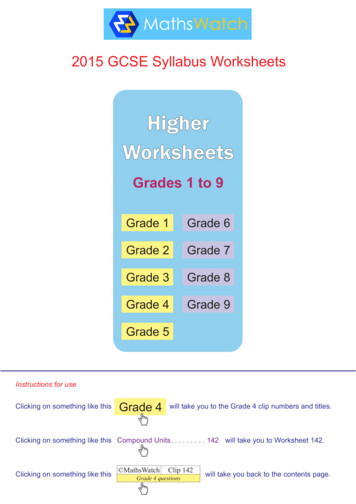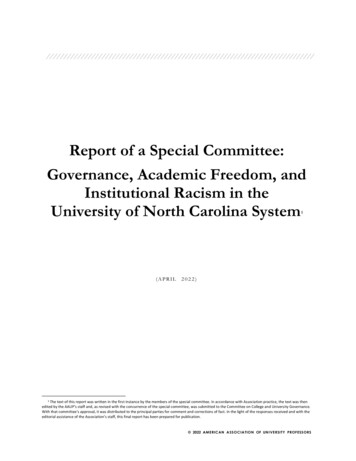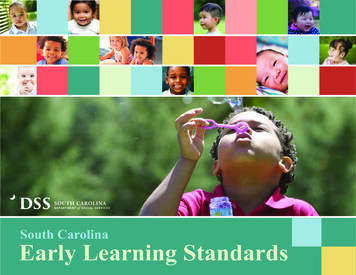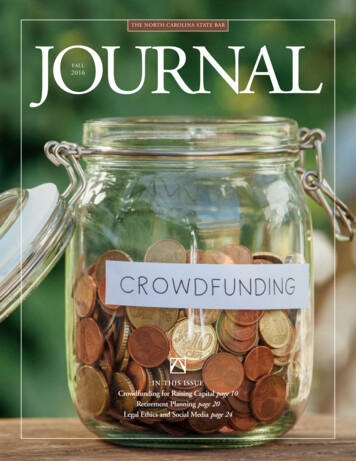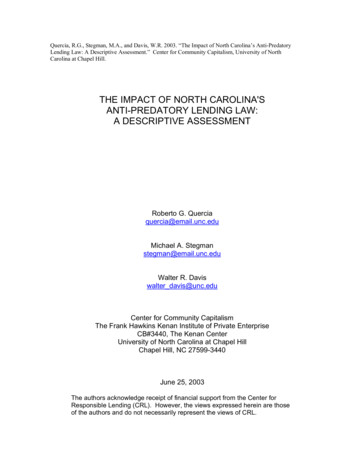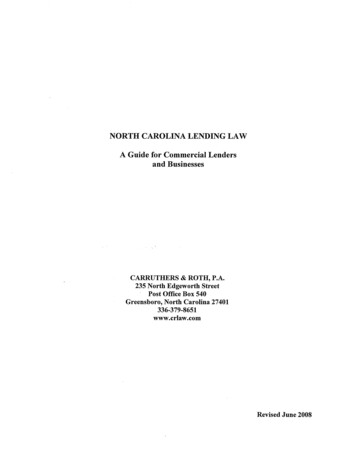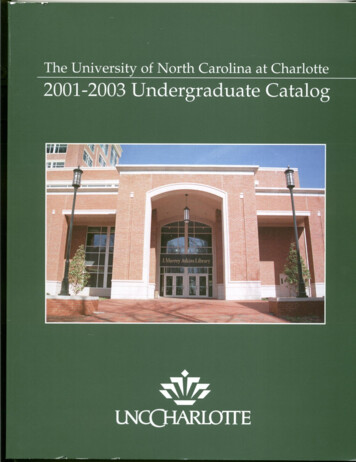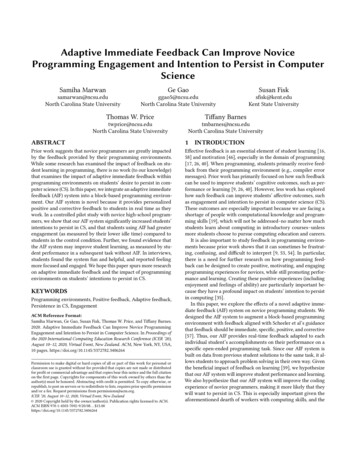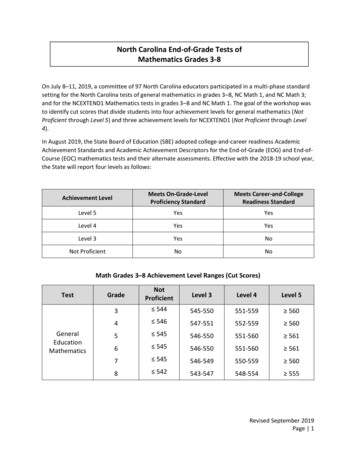
Transcription
North Carolina End-of-Grade Tests ofMathematics Grades 3-8On July 8–11, 2019, a committee of 97 North Carolina educators participated in a multi-phase standardsetting for the North Carolina tests of general mathematics in grades 3–8, NC Math 1, and NC Math 3;and for the NCEXTEND1 Mathematics tests in grades 3–8 and NC Math 1. The goal of the workshop wasto identify cut scores that divide students into four achievement levels for general mathematics (NotProficient through Level 5) and three achievement levels for NCEXTEND1 (Not Proficient through Level4).In August 2019, the State Board of Education (SBE) adopted college-and-career readiness AcademicAchievement Standards and Academic Achievement Descriptors for the End-of-Grade (EOG) and End-ofCourse (EOC) mathematics tests and their alternate assessments. Effective with the 2018-19 school year,the State will report four levels as follows:Achievement LevelMeets On-Grade-LevelProficiency StandardMeets Career-and-CollegeReadiness StandardLevel 5YesYesLevel 4YesYesLevel 3YesNoNot ProficientNoNoMath Grades 3–8 Achievement Level Ranges (Cut icientLevel 3Level 4Level 53 544545-550551-559 5604 546547-551552-559 5605 545546-550551-560 5616 545546-550551-560 5617 545546-549550-559 5608 542543-547548-554 555Revised September 2019Page 1
Mathematics Achievement Level Descriptors – Grade 3Level 5Students at Level 5 demonstrate comprehensive understanding of grade level content standards, are ontrack for career and college, and are prepared for advanced content at the next grade/course.Level 5 students can: Interpret and apply the properties of multiplication and division to solve real-world problems; Solve and interpret one-step real-world problems with unknowns involving addition,subtraction, and multiplication; Multiply and divide with factors, quotients, and divisors up to and including 10, using therelationship between multiplication and division; Interpret and represent two-step real-world problems using equations with unknowns involvingaddition, subtraction, and multiplication; Interpret and apply patterns of multiplication using a hundreds board and/or multiplicationtable; Add and subtract whole numbers up to 1,000 using a variety of strategies to solve two-step realworld problems; Apply place value understanding and properties of operation to find the product of a one-digitwhole number in the range 10–90 in the context of real-world problems; Use models to interpret fractions with denominators of 2, 3, 4, 6, and 8, and explain themeaning of numerators in the context of real-world problems; Represent equivalent fractions by composing and decomposing related fractions using area andlength models; Express whole numbers as fractions and fractions as whole numbers using area and lengthmodels; Compare two fractions with the same denominator or the same numerator using , , and symbols by reasoning about their size; Solve two-step word problems involving the addition and subtraction of time intervals withinthe same hour using a variety of models; Add, subtract, multiply, or divide to solve one-step word problems involving whole-numbermeasurements of length, weight, and capacity in the same customary units; Solve two-step problems from a created frequency table, scaled picture graph, or scaled bargraph involving “how many more” and “how many less”; Find the area of a rectangle by partitioning it into two smaller rectangles, and recognize that thearea of the large rectangle is the sum of the two smaller rectangles; Solve problems involving the perimeter of a polygon with an unknown side length; Compose and decompose quadrilaterals and triangles using attributes.Revised September 2019Page 2
Level 4Students at Level 4 demonstrate a thorough understanding of grade level content standards and are ontrack for career and college.Level 4 students can: Interpret and illustrate products and quotients of two whole numbers with factors, quotients,and divisors up to 10; Solve and interpret one-step multiplication and division word problems with factors, quotients,and divisors up to 10; Determine an unknown in multiplication and division in real-world problems. Multiply and divide with factors, quotients, and divisors up to and including 10; Interpret two-step word problems using addition, subtraction, and multiplication operation witha symbol to represent unknown quantities; Identify and interpret patterns of multiplication using a hundreds board and/or multiplicationtable; Add and subtract whole numbers up to 1,000 using a variety of strategies; Interpret the product of a one-digit whole number and a multiple of 10 in the range 10–90 usingplace value or properties of operation; Use models to interpret fractions with denominators of 2, 3, 4, 6, and 8, and explain themeaning of numerators; Represent equivalent fractions by decomposing area and length models; Recognize and represent fractions as whole numbers less than 4; Compare two fractions with the same denominator or the same numerator using , , and symbols; Solve one-step word problems involving the addition and subtraction of time intervals withinthe same hour using a variety of models; Add and subtract to solve one-step word problems involving whole-number measurements oflength, weight, and capacity in the same customary units; Solve one-step problems from a created frequency table, scaled picture graph, or scaled bargraph involving “how many more” and “how many less”; Find the area of a rectangle with whole-number side lengths by multiplying the side lengths; Solve problems involving the perimeter of polygons, given a context; Describe and compose quadrilaterals and triangles using attributes.Level 3Students at Level 3 demonstrate sufficient understanding of grade level content standards, though somesupport may be needed to engage with content at the next grade/course.Level 3 students can: Represent and interpret products and quotients of two whole numbers with factors, quotients,and divisors up to 10; Solve one-step word problems involving multiplication and division with factors, quotients, anddivisors up to 10; Determine an unknown in multiplication and division equations;Revised September 2019Page 3
Multiply and divide with factors 0–5 and 10;Solve two-step word problems using addition, subtraction, and multiplication with unknowns;Identify patterns of multiplication using a hundreds board and/or multiplication table; Add and subtract whole numbers up to 1,000;Use place value to find the product of a one-digit whole number and a multiple of 10 in therange 10–90;Use models to represent fractions with denominators of 2, 3, 4, 6, and 8;Represent equivalent fractions using area models;Recognize that a fraction with the same numerator and denominator equals one whole;Compare two fractions with the same denominator using , , and symbols;Tell and write time to the nearest minute, and measure time intervals in minutes within thesame hour;Estimate and measure capacity, length (nearest quarter-inch, half-inch, feet and yards to thewhole unit), and weight to the nearest whole unit;Represent and interpret data in a frequency table, scaled picture graph, or scaled bar graph;Find the area of a rectangle by tiling or by multiplying the side lengths;Determine the perimeter of a polygon with given side lengths;Describe quadrilaterals and rectangles using attributes. Not ProficientStudents who are Not Proficient demonstrate inconsistent understanding of grade level contentstandards and will need support.Not Proficient students can: Identify and solve problems with factors, quotients, and divisors up to 10; Represent problems with illustrations to solve a one-step multiplication problem; Determine an unknown in a multiplication problem; Multiply with factors 0, 1, 2, 5, and 10; Solve two-step word problems using addition and subtraction; Identify patterns of multiplication with factors of 2, 5, or 10 using a hundreds board; Add whole numbers up to 1,000; Use models to find the product of a one-digit whole number and a multiple of 10 in the range10–50; Identify unit fractions with denominators of 2, 3, and 4 with area models; Recognize equivalent fractions that are displayed with models; Describe one whole as two halves, three thirds, and four fourths; Use models to compare two fractions with the same denominator using , , and symbols; Tell and write time to the nearest 5 minutes; Estimate and measure length to the nearest half-inch; Interpret data and answer questions about a scaled picture graph or scaled bar graph; Find the area of a rectangle using an array model and repeated addition; Distinguish the difference between area and perimeter;Revised September 2019Page 4
Recognize two-dimensional shapes.Revised September 2019Page 5
Mathematics Achievement Level Descriptors – Grade 4Level 5Students at Level 5 demonstrate comprehensive understanding of grade level content standards, are ontrack for career and college, and are prepared for advanced content at the next grade/course.Level 5 students can: Solve multiplicative comparison (number of groups unknown) word problems; Translate multiplicative comparison situations with multiplier unknown into equations usingsymbols for the unknown, and use them to solve word problems; Distinguish between additive and multiplicative comparison situations to determine a matchingequation; Solve two-step word problems involving the four operations with whole numbers, interpret themeaning of remainders, and use a letter to represent the unknown quantity; Apply understanding of prime and composite numbers to solve contextual, real-worldproblems; Analyze a number pattern and describe the rule; Decompose numbers to 100,000 using nontraditional forms; Compare two multidigit whole numbers up to 100,000 using , , and symbols given in twodifferent forms and grouped nontraditionally; Add and subtract multidigit whole numbers using the standard algorithm with unknown valuesor errors; Solve real-world multistep addition and subtraction word problems; Make connections between multiplication models, and solve real-world multiplication wordproblems; Make connections between division models, and solve real-world division word problems; Apply knowledge of equivalent fractions to solve multistep word problems; Apply knowledge of comparing fractions to compare multiple fractions within contexts; Apply knowledge of decomposing fractions to solve word problems using mixed numbers; Solve multistep word problems involving addition and subtraction of fractions, including mixednumbers with like denominators; Solve multistep word problems involving multiplication of a whole number by a fraction from 0to 1; Use equivalent fractions to add two fractions with denominators of 10 and 100 to solve singlestep word problems; Apply knowledge of comparing decimals to compare multiple decimals within contexts; Solve multistep word problems involving addition and subtraction of time intervals that crossthe hour; Solve multistep word problems involving the area and perimeter of rectilinear figures; Determine whether a survey question will yield categorical or numerical data; Solve multistep problems involving the addition and subtraction of angle measurements; Compare and contrast attributes of two quadrilaterals or triangles.Revised September 2019Page 6
Level 4Students at Level 4 demonstrate a thorough understanding of grade level content standards and are ontrack for career and college.Level 4 students can: Solve multiplicative comparison (group size unknown) word problems; Interpret models, and use them to solve multiplicative comparative word problems; Interpret multiplication equations as comparisons, and use them to solve word problems; Distinguish between additive and multiplicative comparison situations to solve word problems; Solve two-step word problems involving the four operations with whole numbers, and use aletter to represent the unknown quantity; Find all factor pairs for whole numbers up to 50, and determine which numbers are prime orcomposite; Determine the next term in a growing pattern given a sequence of numbers or shapes, anddescribe the features of the pattern; Generate a number or shape pattern that follows a given rule; Read and write multidigit whole numbers up to 100,000 using numerals, number names, andexpanded form; Compare two multidigit whole numbers up to 100,000 using , , and symbols given in twodifferent forms; Add and subtract multidigit whole numbers up to 100,000 using the standard algorithm; Analyze and interpret models for multiplication, and solve real-world multiplication wordproblems; Analyze and interpret models for division, solve real-world division word problems, andinterpret remainders in context when needed; Compare two fractions with different numerators and different denominators (2, 3, 4, 5, 6, 8,10, 12, and 100) using , , and symbols; Apply knowledge of comparing fractions to solve a word problem; Decompose fractions with denominators of 2, 3, 4, 5, 6, 8, 10, 12, and 100 in more than oneway; Justify decompositions using area models, length models, and equations; Solve word problems involving addition and subtraction of fractions, including mixed numberswith like denominators; Solve word problems involving the product of a whole number and a fraction; Model and explain the equivalence between fractions with denominators of 10 and 100; Compare two decimals, one represented as a tenth and the other as a hundredth, using , ,and symbols; Use the four operations to solve one-step word problems involving metric units, includingconversion from a larger unit to a smaller unit; Solve word problems involving addition and subtraction of time intervals that cross the hour; Apply formulas to solve real-world and mathematical problems, including problems with a fixedarea and varying perimeters or a fixed perimeter and varying areas; Interpret data represented in a frequency table, scaled bar graph, or line plot;Revised September 2019Page 7
Apply strategies for addition and subtraction of angles to solve real-world, contextual problems; Classify quadrilaterals and triangles based on angle measures, side lengths, and the absence orpresence of parallel or perpendicular lines.Level 3Students at Level 3 demonstrate sufficient understanding of grade level content standards, though somesupport may be needed to engage with content at the next grade/course.Level 3 students can: Solve multiplicative comparison (unknown product) word problems; Use models to solve a multiplicative comparison word problem; Solve two-step word problems involving the four operations with whole numbers (includingdivision problems with remainders as leftovers) using estimation strategies to assessreasonableness of answers; Find all factor pairs for whole numbers up to 25; Find the next set of terms in a pattern; Determine the next term in a repeating pattern given a sequence of numbers or shapes, anddescribe the features of the pattern; Explain that a digit in one place represents 10 times as much as it represents one place to theright for whole numbers up to 1,000; Read and write multidigit whole numbers up to 100,000 using numerals, number names, orexpanded form; Compare two multidigit whole numbers up to 100,000 using , , and symbols; Add and subtract multidigit whole numbers up to 100,000 with place value understanding; Multiply a two-digit number by a two-digit number, or a one-digit number by a three-digitnumber, using area models, partial products, or properties of operations; Find whole-number quotients and remainders with up to three-digit dividends and one-digitdivisors using multiple methods (rectangular arrays, area models, repeated subtraction, partialquotients, properties of operations, and/or the relationship between multiplication anddivision); Identify fraction equivalence (denominators of 2, 3, 4, 5, 6, 8, 10, 12, and 100); Compare two fractions with different numerators and different denominators (2, 3, 4, 6, and 8)using , , and symbols; Decompose fractions with denominators of 2, 3, 4, 5, 6, 8, 10, 12, and 100; Add and subtract fractions, including mixed numbers with like denominators; Multiply a whole number by a fraction between 0 and 1; Represent tenths and hundredths with models to make connections between fractions anddecimals; Compare two decimals to hundredths using , , and symbols; Use the four operations to solve one-step word problems involving metric units; Solve word problems involving addition of time intervals that cross the hour; Determine the area and perimeter of rectilinear figures with given side lengths; Make a representation in a frequency table, scaled bar graph, or line plot;Revised September 2019Page 8
Solve addition and subtraction problems to find unknown angles; Describe attributes of different quadrilaterals and triangles;Recognize lines of symmetry in two-dimensional figures.Not ProficientStudents who are Not Proficient demonstrate inconsistent understanding of grade level contentstandards and will need support.Not Proficient students can: Solve additive comparison problems; Solve multiplication problems involving equal groups; Solve one-step word problems involving the four operations with whole numbers; Identify a factor pair for any given number, up to and including 50; Identify the next term in a number or shape pattern; Read and write multidigit whole numbers up to 10,000 using numerals and number names; Compare two multidigit whole numbers up to 10,000 using , , and symbols; Add and subtract multidigit whole numbers up to 10,000 using a strategy based on place value; Multiply a two-digit number by a one-digit number using any method; Find whole-number quotients with up to two-digit dividends and one-digit divisors using anymethod; Use models to identify equivalent fractions (denominators of 2, 3, 4, 6, and 8); Compare two fractions with like numerators or denominators (denominators of 2, 3, 4, 6, and8); Decompose fractions using unit fractions; Add and subtract fractions with like denominators from 0 and 1; Use repeated addition as a strategy to multiply a whole number by a unit fraction; Multiply a whole number by a unit fraction; Represent tenths and hundredths with models; Compare two decimals to tenths using , , and symbols; Select appropriate units of measurement for a given attribute; Solve word problems involving addition of time intervals within the hour; Determine the area and perimeter of rectangles; Make a representation in a frequency table, scaled bar graph, or scaled picture graph; Use 90- and 180-degree angles to benchmark the measurement of other angles. Identify points,lines, line segments, rays, and angles; Identify points, lines, line segments, rays, and angles. Draw and identify parallel or perpendicular lines; Identify quadrilaterals (rhombuses, rectangles, squares, parallelograms, and trapezoids).Revised September 2019Page 9
Revised September 2019Page 10
Mathematics Achievement Level Descriptors – Grade 5Level 5Students at Level 5 demonstrate comprehensive understanding of grade level content standards, are ontrack for career and college, and are prepared for advanced content at the next grade/course.Level 5 students can: Apply the order of operations and the commutative, associative, and distributive properties tosolve two-step word problems using a variety of number sentences; Analyze the relationship between the two sets of data solving real-world word problems byextending and continuing the pattern; Compare more than two decimals to the thousandths based on the value of the digits in eachplace, using , , and symbols in multistep real-world problems; Multiply two multidigit whole numbers using the standard algorithm while making a connectionusing models with unknown values, and solve real-world multistep word problems; Interpret the remainder when dividing whole numbers with up to four-digit dividends and twodigit divisors using multiple methods in real-world multistep word problems; Add, subtract, and multiply decimals to thousandths using multiple methods based on placevalue in multistep word problems, using estimation to assess reasonableness of answers; Solve multistep word problems using at least two of the four operations and using decimalnumbers; Apply multiple strategies to add and subtract fractions, including mixed numbers, with unlikedenominators to solve real-world multi-operational word problems; Solve one-step word problems involving division of whole numbers leading to answers that arefractions and mixed numbers using more than one strategy; Explain why multiplying a given number by a fraction greater than 1 or less than 1 results in aproduct greater than or less than the given number when solving one-step word problems; Solve one-step conversion problems within a given measurement system when given a chart in amultistep real-world word problem; Solve one- and two-step word problems, and formulate questions that will yield data thatchanges over time; Solve multistep word problems when unknown dimensions are included; Solve multistep real-world word problems, including traveling from one point to another andidentifying the coordinates of missing points in geometric figures; Determine quadrilaterals in a hierarchy based on congruence and similarity, and applyknowledge of the hierarchy in a word-problem context.Level 4Students at Level 4 demonstrate a thorough understanding of grade level content standards and are ontrack for career and college.Level 4 students can: Write, explain, and evaluate numerical expressions with parentheses using the order ofoperations and commutative, associative, and distributive properties that involve the fouroperations to solve up to two-step problems;Revised September 2019Page 11
Form ordered pairs of corresponding terms from the patterns that can be graphed on the firstquadrant of a coordinate plane;Read, write, and compare decimals and fractional notation for tenths, hundredths, andthousandths using base-ten numerals, number names, and expanded form;Multiply a three-digit number by a two-digit number using the standard algorithm in real-worldword problems;Interpret remainders when dividing whole numbers with up to four-digit dividends and two-digitdivisors using multiple methods in real-world word problems;Add, subtract, and multiply decimals to thousandths using multiple methods based on placevalue in a word problem using estimation to assess reasonableness of answers;Divide a whole number by a decimal and divide a decimal by a whole number to the hundredthsin a word problem using repeated subtraction or area models;Add and subtract related fractions, including mixed numbers (including regrouping), with unlikedenominators in two-step word problems using area and length models, and use estimation todetermine the reasonableness of an answer;Solve one-step word problems involving division of whole numbers leading to answers that arefractions and mixed numbers using area, length, and set models or equations;Multiply a fraction by a fraction, including a mixed number, and solve one-step word problemsinvolving multiplication of fractions;Solve one-step word problems involving division of unit fractions by nonzero whole numbers aswell as whole numbers by unit fractions;Use multiplicative reasoning to solve one-step conversion problems within a givenmeasurement system when given a chart;Interpret data on a line graph, and determine whether a survey question will yield categorical ornumerical data, or data that changes over time;Solve problems involving rectangular prisms with whole-number edge lengths, and find thevolume of solid figures with one-digit dimensions composed of two nonoverlapping rectangularprisms;Interpret x- and y-coordinates of points plotted in the first quadrant of the coordinate plane tosolve problems;Classify quadrilaterals in a hierarchy based on properties, and label quadrilaterals using all of theother names of quadrilaterals based on their attributes.Level 3Students at Level 3 demonstrate sufficient understanding of grade level content standards though somesupport may be needed to engage with content at the next grade/course.Level 3 students can: Write, explain, and evaluate numerical expressions that involve the four operations to solve upto two-step problems; Generate two numerical patterns using two given rules; Read, write, and compare decimals using base-ten numerals, number names, and expandedform; Multiply a two-digit number by a two-digit number using the standard algorithm; Find quotients with remainders when dividing whole numbers with up to four-digit dividendsand two-digit divisors using any method;Revised September 2019Page 12
Add, subtract, and multiply decimals to thousandths using any method based on place value;Add and subtract related fractions with unlike denominators in one-step word problems usingbenchmark fractions and area and length models;Interpret and model a fraction as a division problem;Multiply a fraction by a fraction using area and length models;Use area and length models to divide unit fractions by whole numbers and whole numbers byunit fractions;Convert one-step conversion problems within a given measurement system when given a chart;Make a representation of data using a line graph;Find volume by counting unit cubes, and find the volume of rectangular prisms in cubic unitswith whole-number edge lengths;Identify graph points with whole numbers in the first quadrant of the coordinate plane;Recognize that the attributes that belong to a category of quadrilaterals also belong to allsubcategories of that category.Not ProficientStudents who are Not Proficient demonstrate inconsistent understanding of grade level contentstandards and will need support.Not Proficient students can: Evaluate numerical expressions that involve the four operations to solve one-step problems; Generate a number pattern that follows a given rule; Read and write multidigit whole numbers up to and including 100,000 using numerals, numbernames, and expanded form; Use models to multiply a whole number up to three digits by a one-digit whole number, andmultiply up to two two-digit numbers; Find whole-number quotients and remainders with up to three-digit dividends and one-digitdivisors with place value understanding using one of the following methods: rectangular arrays,area models, repeated subtraction, partial quotients, properties of operations, or therelationship between multiplication and division; Add and subtract decimals to hundredths using any method based on place value; Add and subtract fractions with like denominators using area and length models and equations; Demonstrate an understanding that fractions are an equal sharing context where a quantity isdivided into equal parts; Multiply a fraction by a whole number; Use area or length models to divide whole numbers by fractions; Demonstrate knowledge of customary and metric units of measurement; Organize data in a table; Identify length and width of a rectangle, and find the area in square units to identify the base ofa rectangular prism; Identify points on a number line; Name quadrilaterals based on angle measure, side lengths, and the presence or absence ofparallel or perpendicular lines.Revised September 2019Page 13
Mathematics Achievement Level Descriptors – Grade 6Level 5Students at Level 5 demonstrate comprehensive understanding of grade-level content standards, are ontrack for career and college, and are prepared for advanced content at the next grade/course.Level 5 students can: Apply use of scale factor to solve multistep real-word ratio problems in context; Solve multiple unit conversions of different quantities in the ratio (converting and manipulatingmeasurements); Create and use a table to solve real-world problems, using pairs of values from a coordinategrid; Solve multistep real-world problems involving the quotients of fractions in context; Solve real-world multistep problems, using long division involving a minimum of four-digitdividends, and interpret the meaning of remainders in context; In multistep real-world mathematical word problems, add, subtract, multiply, and dividedecimals using the standard algorithms; Find the greatest common factor in real-world context of two whole numbers less than or equalto 100, and use the distributive property to rewrite the sum of two whole numbers; Find the least common multiple in real-world context of two whole numbers to add and subtractfractions with unlike denominators; Interpret how ordered pairs relate to each other on the coordinate plane; Use coordinates and absolute value to find the distance between points with the same firstcoordinate or the same second coordinate, using real-world situations (map); Use models to add and subtract integers in multistep problems involving real-world contexts; Write and evaluate algebraic expressions that include whole numbers, fractions, exponents, anddecimals, using mathematical reasoning to develop a proper sequence of steps; Apply and describe properties of operations to generate equivalent expressions involvingexponents from real-world situations; Use multiple substitutions to determine whether a number makes an equation or inequality trueinvolving exponents; Apply and use variables from real-world contexts to model and analyze the relationshipbetween dependent variables and independent variables; Given three vertices and the perimeter of a polygon, determine the ordered pair of the missingvertex on the coordin
Revised September 2019 Page 4 –Multiply and divide with factors 0 5 and 10; Solve two-step word problems using addition, subtraction, and multiplication with unknowns; Identify patterns of multiplication using a hundreds board and/or multiplication table; Add and subtract whole numbers up to 1,000; Use place value to find th


